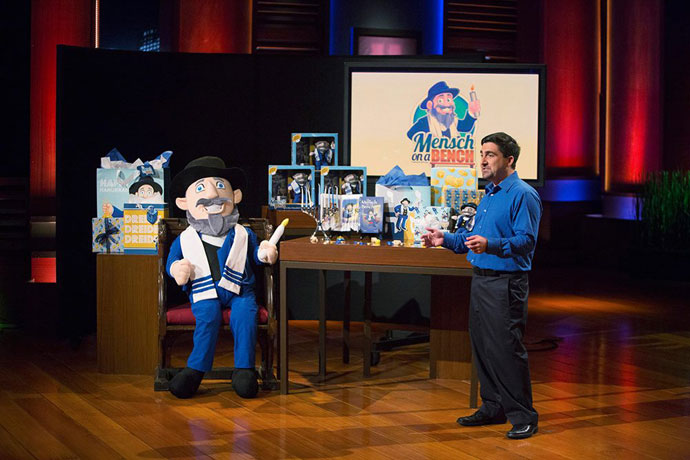‘I Believe In This Business’: An Interview With The Brains Behind The Mensch On A Bench

Image via Facebook/ Mensch On A Bench
The newest holiday craze to hit retail stores, the Mensch on a Bench, began as a hobby, evolved into a Kickstarter campaign in early 2013 and was recently featured on ABC’s “Shark Tank,” netting a $150,000 investment from two of the sharks. How did creator Neal Hoffman do it all? Wall Street Insanity spoke with him to find out about his experience on “Shark Tank” and his future plans for the Mensch on the Bench.
Although Hoffman seemed confident and prepared during his appearance on “Shark Tank,” he confesses that he wasn’t just nervous before going on the show; he was terrified
Terrified. I mean absolutely terrified,” he says. “What I tell people is I like to think I was the most prepared person ever to walk on that show — I had read all of their books, I had watched every episode, I had listened to every podcast…[but] when you walk into the room there’s about 45 seconds where you just stand and face the cameras… and you’re not allowed to talk to them. You just sit there and stare at these people… and they’re staring at you and sizing each other up. It was exciting and nerve -wracking all at once.”
During his presentation to the sharks, Hoffman explained the story behind the Mensch on a Bench, including his interfaith marriage and how he’s raising his son as Jewish, which provided inspiration for this Hanukkah alternative to the ubiquitous Elf on the Shelf. The Mensch on a Bench is intended to be an educational tool for kids to learn more about their Jewish heritage, as well as a “seasonal brand.”
Some of the sharks were receptive to the idea, but a few had some criticisms that Hoffman says he wasn’t quite prepared for, including the doll’s expression.
I thought that I’d prepared much more so for defending the seasonality of it and the size of the business; I didn’t think that they were going to say they didn’t like the face,” he says, adding that this is his first time making a doll. However, he also says he’s hired people to “explore what different iterations of the face could look like,” and says that the sharks’ suggestions were all “very fair.”
In the end, however, the positives outweighed the negatives. Barbara Corcoran offered $150,000 for 20 percent of the company while Lori Greiner and Robert Herjavec offered $150,000 for 15 percent. Hoffman chose the latter, but says he was “thrilled” to get two offers.
Getting one offer is amazing, much less two; it’s a plethora of riches,” he says. As a self-proclaimed “huge fan” of the show, he’s excited to work with Greiner and Herjavec.
This new contract comes with a price, however — Hoffman personally guaranteed the return of the investors’ money in three years.
When asked about the risks of expanding the Mensch on a Bench after making this guarantee, Hoffman said that essentially boils down to the dangers of success and the dangers of failure. For example, if the company ends up doing really well in the next year and he makes half a million dollars, he’ll owe the investors another $75,000 out of his own pocket. If retailers decide not to buy the Mensch next year or it doesn’t sell, “I’m on the hook for $150,000,” he says.
Still, he seems confident about the Mensch’s success.
I’m OK with that risk; I believe in this business,” he says.
Swimming with the Sharks
What was it like confronting each individual shark?
Barbara was such a sweetheart,” Hoffman says of the shark whose offer he ended up declining. “Kevin was very serious…Robert has these blue eyes that pierce you…and he’s just so intense! He’s the one whose presence is larger than life.”
Extolling the investment and business experience of his new investors, Hoffman says that having Lori Greiner as a partner is “amazing.”
Growing the Mensch
While on “Shark Tank,” Hoffman told his potential investors that he didn’t just want to sell a seasonal product — he wanted to sell a seasonal brand.
What I envision is creating an intellectual property that can add excitement to Judaism,” he tells Wall Street Insanity. “It isn’t just an item; you could get Mensch on a Bench dreidels, wrapping paper, candy bars, gelt… anything that can bring the family together to have fun.”
His mission is to expand the brand so customers can choose between several different Mensch items during the Hanukkah season. The $150,000 from “Shark Tank” will likely go toward this expansion, although as of yet, Hoffman says he hasn’t had to use the money.
I’ve talked to [the investors], and the way our deal is structured is that if we need that money, we’ll ask for that money.”
He explains that right now, the Mensch on a Bench is doing well, so the company is building up cash reserves for next year. When that money is finally used, he predicts that it will be used for things like marketing and creating inventory for 2015.
Will the Mensch on a Bench be seen in more stores next year as well? Probably not, says Hoffman; it’s already being distributed in major retailers like Target and Barnes and Noble, and “getting the dolls in front of people isn’t the issue.” He says that rather than looking to get the Mensch “into more doors,” he’d rather grow the brand by getting more Mensch-branded items into the stores the dolls are already in. However, that doesn’t mean other stores won’t be considered.
I think we’ll expand where it makes sense,” he says. “Companies that are doing big Hanukkah business — we want to expand into [those].”
Inspiration and Hopes for the Future
Hoffman’s time as a toy executive at Hasbro inspired him, he says. He loved his job but had to quit because of a move to Cincinnati, Ohio, and ended up missing it.
Being away from that, I missed it a lot; all I wanted was to get back into the toy industry.”
The Mensch on a Bench started out as a hobby — something he could have fun with and experiment with. Eventually, however, “it took on a life of its own,” according to Hoffman.
He hopes that the Mensch will instill good values in the kids who experience it and perhaps even become a Hanukkah icon someday.
My hopes that are 20 years from now, there will be a generation of kids that always knew Mensch on a Bench, that grew up with Mensch on a Bench,” he says. Using environmentalist superhero Captain Planet as an example of a cultural icon that promoted a positive agenda, he says he wants to do the same thing, and hopes to instill the idea of being a good person in kids and hand that down from generation to generation.
He also emphasizes that the Mensch on a Bench wasn’t created to make money.
It’s not to get rich and sell the company and retire on the beach; I love talking to people about this. I answer every tweet, every Facebook message, every call… I absolutely love it. I want to teach my own kids [to] find something you have passion for and go after it.”
So how is the toy that began with a $22,000 Kickstarter campaign doing this December?
We don’t have our final numbers yet, as we are not getting POS from the stores on a daily basis… [but] in retail dollars we will sell well over a million dollars of Mensches!” says Hoffman.
It looks like Moshe the Mensch is well on his way toward taking over Hanukkah!









































